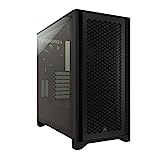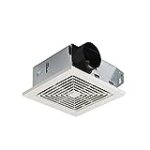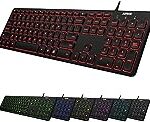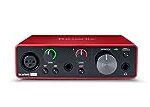🌅 Introduction
Welcome to our comprehensive computer cases buying guide! Whether you’re a gaming enthusiast, a professional designer, or simply someone who wants to build their dream PC, choosing the right computer case is crucial. From sleek and minimalist designs to those with RGB lighting and tempered glass panels, the options are endless. In this guide, we will walk you through the key factors to consider when purchasing a computer case, including size, airflow, cable management, and aesthetics. So, let’s dive in and find the perfect computer case that suits your needs and elevates your PC setup to the next level!
🏆 Our Top 5
- Combining innovative cable management, concentrated airflow, and proven CORSAIR build quality, the 4000D is a fitting choice for an immaculate high-performance PC..Maximum PSU Length : 220. Radiator Compatibility : 120mm, 140mm, 240mm, 280mm, 360mm.
- The CORSAIR RapidRoute cable management system makes it simple and fast to route your major cables through a single channel, with a roomy 25mm of space behind the motherboard for all of your cables.
- Includes two CORSAIR 120mm AirGuide fans, utilizing anti-vortex vanes to concentrate airflow and enhance cooling. Motherboard will fit in our 4000 Series cases without any issue. Mini-ITX, micro-ATX, ATX, and E-ATX form factor motherboards are all supported.
- A spacious interior fits up to 6x 120mm or 4x 140mm cooling fans, along with multiple radiators including 360mm in front and 280mm in the roof (dependent on RAM height).
- Put modern connections within easy reach with a front I/O panel including a USB 3.1 Type-C Port, USB 3.0 port, and a combination audio/microphone jack.
- 【Item Dimension & Motherboard Support】436mm * 210mm * 486mm (D * W * H);Compatible with ATX / MATX / ITX motherboards;
- 【Panoramic Design with 270°Wide Angle View】The 270°panoramic mid tower case features fully glass-covered front and side panels, providing a clear view of internal hardware. Diamond cut angles offer a transparent and aesthetically pleasing display, creating a unique visual effect;
- 【Synchronized Dual-Channel Airflow Design with 3 X H12 Reverse PWM ARGB Fans at the PSU Chamber and 2 X H12 Reverse PWM ARGB Fans at the Side】Carefully designed vertical and horizontal airflow channels. At the top of the PSU chamber, experience the intricately crafted vertical airflow path with 3 x H12R PWM ARGB reverse fans, ensuring efficient heat dissipation. Meanwhile, the lateral side showcases the horizontal airflow channel, achieved by 2 x H12R PWM ARGB reverse fans and 1 x H12 PWM ARGB fan at the rear;
- 【Exquisite Steel Mesh - 1.2mm, Finer Grid Compare to 3.0mm】The uniquely crafted 1.2mm mesh design optimizes heat dissipation and prevents heat buildup, ensuring streamlined airflow. This fine mesh surpasses both aesthetically and functionally over the traditional 3.0mm counterparts, providing excellent dust resistance, broad applicability, and durability;
- 【Multi-Functional Zone for Readily Accessible User-Computer Interaction】Introducing feature-rich Multi-function Zone, effortlessly manage your device's power status with the power switch, customize your case lighting with the ARGB fan control buttons, and enjoy seamless connectivity with two USB 3.0 ports, audio jacks, and a lightning-fast Type-C 3.2 Gen 2 (10Gbps) interface. Experience fast data transfer, high-quality audio, and easy device connections—all at your fingertips;
- Wraparound glass panels with a seamless edge provides an unobstructed view of the inside to highlight key components.
- Compact dual-chamber design improves overall thermal performance and creates a clean, uncrowded aesthetic.
- Includes three pre-installed 120mm fans positioned at an ideal angle for superb out-of-the-box cooling.
- The top and side panels feature an airflow-optimized perforation pattern to enhance overall performance and filter dust.
- An intuitive cable management system simplifies the build process by using wide channels and straps.
- Magnetic Dust Filters: The unique pattern of the dust filter adds a distinctive appearance to the case.
- Components Clearance: Accommodates CPU coolers with a max height of 159mm, GPU cards up to 360mm, and PSU up to 160mm in length.
- Versatile Cooling: Maximize cooling performance with a 240mm liquid cooler and 5 fans.
- Modular I/O Panel: You have the flexibility to adjust its position at the front, top, or bottom on both sides
- Edge-To-Edge Panel: Show off your meticulous build through the transparent side panel with pride.
- Panoramic Views: No corner pillar. The Y60 features a 3-piece panoramic tempered glass design for the ultimate photo and display potential. See your build the way it was meant to be seen from the left or right side of your desk with a simple turn.
- Exclusively Vertical GPU Mounted: Why would you want to see your graphics card any other way.
- Included PCIE 4.0 Riser Cable: A protective riser cable canopy integrates beautifully into the case, allowing for half-height PCIE cards behind the throne of the vertical graphics card. The protective shroud is the first of its kind, made specifically for the Y60.
- Antechamber Construction: Segment cables from thermal components and turn your PC into a work of art.
- Cold Floor Cooling: Eliminate hot spots with sweeping lateral vents from fans tastefully tucked into the basement of the Y60.
🤔 How to choose?
1. Size Matters
When it comes to choosing a computer case, size matters. The size of your case will determine the compatibility of your components and the overall functionality of your system.
**Before making a purchase, measure the available space where you plan to place your computer case.** Consider the dimensions of the case, including its height, width, and depth. This will ensure that the case fits perfectly in your designated area and allows for proper airflow.
2. Compatibility Considerations
Another crucial factor to consider when choosing a computer case is compatibility. You need to ensure that the case is compatible with your chosen motherboard form factor, power supply, and cooling system.
**Check the specifications of your motherboard and power supply to determine the form factor you need.** Common form factors include ATX, Micro ATX, and Mini ITX. Additionally, consider the number and size of drive bays, as well as the maximum length of graphics cards that the case can accommodate.
3. Cooling Capabilities
Proper cooling is essential for maintaining the longevity and performance of your computer components. When selecting a computer case, pay attention to its cooling capabilities.
**Look for cases that offer ample space for fans and radiators, as well as proper ventilation and cable management options.** Consider the number and size of fans that can be installed, as well as the presence of dust filters to prevent dust buildup. Additionally, some cases come with built-in fan controllers or RGB lighting options for added customization.
4. Build Quality and Aesthetics
The build quality of a computer case can significantly impact its durability and overall aesthetics. **Opt for cases made from high-quality materials such as steel or aluminum, as they offer better structural integrity and heat dissipation.**
Consider the design and aesthetics of the case as well. Choose a case that aligns with your personal style and complements your existing setup. Some cases come with tempered glass side panels, allowing you to showcase your components and create a visually appealing build.
5. Additional Features and Expandability
Lastly, consider the additional features and expandability options that a computer case offers. These can enhance the functionality and convenience of your system.
**Look for cases that provide ample storage options, such as multiple drive bays or support for SSDs and HDDs.** Consider the presence of front panel ports, such as USB 3.0 or USB-C, for easy connectivity. Additionally, some cases offer modular designs or removable drive cages, allowing for easy customization and future upgrades.
In conclusion, choosing the right computer case is crucial for building a functional and visually appealing system. Consider the size, compatibility, cooling capabilities, build quality, and additional features of the case to ensure a seamless and enjoyable computing experience. Remember, a well-chosen case can be the foundation of a powerful and efficient computer setup.
💡 What to Look for in a computer cases?
1. Compatibility and Size
When it comes to choosing a computer case, compatibility and size are two crucial factors to consider. The case should be able to accommodate all the components you plan to install, such as the motherboard, graphics card, and power supply.
A spacious case with ample room for expansion is essential, especially if you are planning to upgrade your system in the future. Additionally, it is important to ensure that the case is compatible with the form factor of your motherboard, whether it is ATX, Micro-ATX, or Mini-ITX.
For example, if you have a high-end gaming rig with a large graphics card, you would need a case with sufficient clearance and support for long graphics cards. On the other hand, if you are building a compact system for office use, a smaller form factor case would be more suitable.
2. Cooling and Airflow
Proper cooling is essential for maintaining optimal performance and longevity of your components. When selecting a computer case, it is important to consider its cooling capabilities and airflow design.
Look for a case that offers good ventilation, with multiple fan mounts and dust filters to prevent dust buildup. This will help keep your components cool and reduce the risk of overheating.
Additionally, consider the placement of fans and the possibility of adding liquid cooling solutions if you plan to overclock your system or use high-performance components. A case with well-designed airflow can make a significant difference in temperature management.
3. Design and Aesthetics
While functionality is important, the design and aesthetics of a computer case can also play a significant role in your overall satisfaction with your build. The case should reflect your personal style and preferences.
Consider factors such as the overall design, color options, and the availability of tempered glass side panels to showcase your components. Some cases even offer customizable RGB lighting options, allowing you to create a unique and visually appealing setup.
Remember, a computer case is not just a functional component; it is also a statement piece that can enhance the overall look of your setup.
By considering compatibility and size, cooling and airflow, and design and aesthetics, you can make an informed decision when choosing a computer case that meets your needs and preferences. Whether you are a gamer looking for a high-performance case or a professional seeking a sleek and stylish design, there is a wide range of options available to suit every requirement.
🔍 How we picked?
1. Researching the Options
When it comes to buying a computer case, it’s important to do your research and explore the various options available in the market. With so many different brands, sizes, and features to choose from, finding the perfect case for your needs can be overwhelming. That’s why we’ve done the legwork for you and narrowed down the top choices based on our extensive research and expertise in the field.
To begin our selection process, we scoured online forums, customer reviews, and expert opinions to identify the most popular and highly recommended computer cases. We also took into consideration factors such as build quality, airflow, cable management, and overall design. By analyzing these key aspects, we were able to create a shortlist of the best computer cases on the market.
2. Evaluating Build Quality and Design
One of the most important factors to consider when choosing a computer case is its build quality. A well-built case not only ensures the longevity of your components but also provides a sturdy and reliable platform for your PC. We carefully examined the materials used, the overall construction, and the attention to detail in each case we reviewed.
In addition to build quality, the design of a computer case plays a crucial role in its functionality and aesthetics. We looked for cases that offer ample space for components, easy access to ports and drives, and efficient cable management options. A well-designed case not only enhances the overall user experience but also allows for better airflow and cooling, which is essential for maintaining optimal performance.
3. Considering User Feedback and Expert Opinions
To ensure that our recommendations are reliable and trustworthy, we took into account both user feedback and expert opinions. We analyzed customer reviews from reputable sources and paid close attention to the common praises and criticisms of each case. This allowed us to gain valuable insights into the real-world experiences of users and identify any potential issues or limitations.
Furthermore, we consulted with industry experts and professionals who have extensive knowledge and experience in building and using computer systems. Their expertise helped us validate our findings and provided additional insights into the pros and cons of each case. By combining user feedback and expert opinions, we were able to create a comprehensive and well-rounded list of the best computer cases available.
By conducting thorough research, evaluating build quality and design, and considering user feedback and expert opinions, we have curated a selection of the top computer cases on the market. Whether you’re a casual user or a hardcore gamer, our buying guide will help you make an informed decision and find the perfect case to suit your needs.
💬 Frequently asked questions about computer cases
1. What factors should I consider when buying a computer case?
When purchasing a computer case, there are several important factors to consider. Firstly, you should think about the size of the case and whether it will fit all of your components comfortably. This is especially crucial if you have a larger graphics card or multiple storage drives. Secondly, consider the airflow and cooling options of the case. Look for cases with good ventilation and the ability to accommodate additional fans if needed. Lastly, think about the overall design and aesthetics of the case. After all, you want your computer to look as good as it performs.
2. How do I determine the size of the computer case I need?
Determining the size of the computer case you need is relatively straightforward. The most common sizes are ATX, Micro-ATX, and Mini-ITX. ATX cases are larger and can accommodate more components, while Micro-ATX and Mini-ITX cases are more compact. To determine the size you need, consider the number of expansion slots you require and the size of your motherboard. If you have a standard ATX motherboard, an ATX case would be the best fit. However, if you have a smaller Micro-ATX or Mini-ITX motherboard, you should opt for a case that matches the size.
3. How important is cable management in a computer case?
Cable management is a crucial aspect of any computer case. Proper cable management not only improves the overall aesthetics of your build but also enhances airflow and cooling efficiency. By neatly routing and securing cables, you can prevent them from obstructing airflow and potentially causing overheating issues. Additionally, organized cables make it easier to troubleshoot and upgrade your components in the future. Look for cases with ample cable management options, such as rubber grommets, Velcro straps, and dedicated cable routing channels.
4. Are there any specific features I should look for in a computer case?
While the specific features you need will depend on your individual requirements, there are a few key features that are worth considering. Firstly, **dust filters** are essential for keeping your components clean and preventing dust buildup. Secondly, **removable drive cages** can provide flexibility when it comes to storage options and allow for easier installation of larger components. Lastly, **front panel connectivity** is important if you frequently use USB devices or headphones, so look for cases with conveniently located ports.
5. Can I upgrade my computer case in the future?
Yes, you can definitely upgrade your computer case in the future. However, it’s important to ensure compatibility with your existing components. As long as your motherboard and other components fit within the new case, you can easily transfer them over. Keep in mind that upgrading your case can be an opportunity to improve airflow, cable management, and overall aesthetics. So, if you find yourself needing more space or wanting a different design, don’t hesitate to upgrade your computer case.
Last update on 2024-07-21 / Affiliate links / Images from Amazon Product Advertising API















